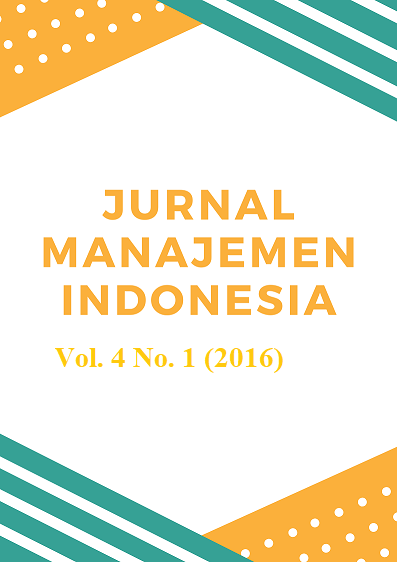ANALISIS KOLEKTIBILITAS KREDIT UNTUK MENGETAHUI TINGKAT KESEHATAN KREDIT DAN DAMPAKNYA TERHADAP TINGKAT KESEHATAN BANK PADA PT BPR NUR ABADI DI DESA SANGSIT PERIODE 2013-2015
Abstract
Penelitian ini bertujuan untuk menganalisis secara empiris (1) Tingkat kesehatan kredit dengan menggunakan rasio kolektibilitas kredit terhadap total kredit, Nilai Kolektibilitas Kredit (NKK), dan Non Performing Loan (NPL). (2) Tingkat kesehatan Bank PT BPR Nur Abadi dilihat dari Kualitas Aktiva Produktif (KAP). Desain penelitian yang digunakan adalah analisis deskriptif kuantitatif. Subjek penelitian adalah PT BPR Nur Abadi, dan objek penelitian adalah Laporan Nominatif Kredit yang terdiri dari jumlah debitur, jumlah pinjaman debitur, dan kolektibilitas kredit dari debitur. Data dikumpulkan dengan pencatatan dokumen, kemudian dianalisis menggunakan analisis rasio kolektibilitas kredit terhadap total kredit, Kolektibilitas Kredit (NKK), Non Performing Loan (NPL) dan Kualitas Aktiva Produktif (KAP). Hasil penelitian ini menunjukkan bahwa: (1) Dari tahun 2013 sampai dengan 2015 kondisi tingkat kesehatan kredit PT BPR Nur Abadi mendapatkan predikat sehat hal ini ditunjukkan dengan rata-rata nilai rasio kolektibilitas kredit terhadap total kredit sebesar 96,03%, rata-rata nilai kolektibilitas kreditnya sebesar 2,71%, dan persentase rata-rata non performing loan sebesar 3,97%. (2) Kondisi tingkat kesehatan Bank PT BPR Nur Abadi mendapatkan predikat sehat hal ini ditunjukkan dengan rata-rata nilai rasio kualitas aktiva produktif pada tahun 2013 sebesar 103,16, pada tahun 2014 sebesar 103,03 dan pada tahun 2015 sebesar 103,27.Kata Kunci : KAP, Kolektibilitas, NKK, dan NPL.
This study aims to analyze empirically (1) The level of credit health by using the ratio of loan collectibility to total loan, value collectibility of the loans, and non performing loan. (2) The soundness of bank PT BPR Nur Abadi judging from the quality of earning assets. The research design used is quantitative descriptive analysis. The subjects were all of PT BPR Nur Abadi, and the object is nominative credit report consisting of total debtors, total loan debtors, and collectibility of the loans from debtors. Data collected by documentation, then analyzed by using the ratio of loan collectibility to total loan, value collectibility of the loans, non performing loan and assets quality of earning assets. The results showed that: (1) From 2013 to 2015 the health level of credit conditions PT BPR Nur Abadi getting healthy predicate as shown by the average value of the ratio of the collectibility of loans to total loans amounted to 96,03%, the average value of the collectibility of credit amounting to 2,71% and the average percentage of non performing loans amounted to 3,97%. (2) The health level of credit conditions PT BPR Nur Abadi getting healthy predicate as shown by the average value of the ratio of the quality of earning assets in 2013 amounted to 103,16, in 2014 amounted to 103,03 and in 2015 amounted to 103,27.
keyword : KAP, Collectibility, NKK and NPL.
Published
2016-07-13
How to Cite
., I. A. K. U. S., ., G. P. A. J. S. S., & ., N. N. Y. S. (2016). ANALISIS KOLEKTIBILITAS KREDIT UNTUK MENGETAHUI TINGKAT KESEHATAN KREDIT DAN DAMPAKNYA TERHADAP TINGKAT KESEHATAN BANK PADA PT BPR NUR ABADI DI DESA SANGSIT PERIODE 2013-2015 . Jurnal Manajemen Indonesia, 4(1). Retrieved from https://ejournal.undiksha.ac.id/index.php/JMI/article/view/7392
Issue
Section
Articles






